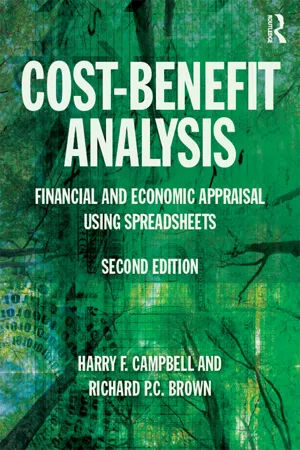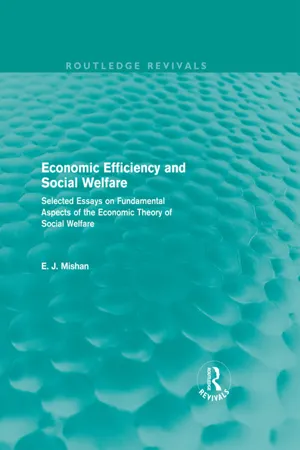Consumer Surplus Formula
Consumer surplus is a measure of the benefit that consumers receive from purchasing a good or service at a price lower than the maximum they are willing to pay. The formula for consumer surplus is the difference between what consumers are willing to pay and what they actually pay for a good or service. It is calculated as the area of the triangle under the demand curve and above the price.
7 Key excerpts on "Consumer Surplus Formula"
- eBook - ePub
Pricing on Purpose
Creating and Capturing Value
- Ronald J. Baker(Author)
- 2010(Publication Date)
- Wiley(Publisher)
...While the consumer surplus is the gain the buyer receives from trade, the producer surplus is sometimes referred to as economic rent —the amount received by sellers of an item over and above what they would have accepted. Michael Jordan and Tiger Woods receive an enormous amount of economic rent above what would be needed to induce them to play their favorite sport. There is also a consumer detriment, representing the customers who are willing to pay more than cost but less than the market price. While consumer surplus makes customers happy, it is economic rent that makes companies—and individuals—rich. In fact, because of this fact, some economists believe Marshall should have called his scissors “sales curves” and “bid curves” rather than supply and demand curves, since what they are really depicting is the highest price an individual would be willing to pay, or the lowest a seller would accept, for a given amount of product. If a business can identify those customers willing and able to pay more, it can capture a portion of this consumer surplus. It is there for any company with a downward sloping demand curve, which is present even for the most elastic demand curves. What if the bookstore owner had known me, and my quest to find the rare Stanley Marcus book? Perhaps with the sophisticated customer relationship management (CRM) software of today he could track the desires of his customers and this would certainly assist him in pricing to capture a larger share of the consumer surplus. Yet, identifying these particular customers is only part of the puzzle, however, since then you have to charge different prices to different customers, and this presents some challenges, although not insurmountable. Charging different prices to different customers is the definition of price discrimination, a term coined in 1920 by Arthur Cecil Pigou in The Economics of Welfare...
- eBook - ePub
- Bonnie Nguyen, Andrew Wait(Authors)
- 2015(Publication Date)
- Routledge(Publisher)
...That is, consumer surplus is given by the consumer’s willingness to pay, minus the price actually paid, for each unit bought. To provide some intuition for this, suppose Hamish is considering buying a chocolate bar. His willingness to pay (or marginal benefit) for the chocolate bar is $5.50, but the price of chocolate bars is $2. If he buys the chocolate bar, he will receive $5.50 of benefits, minus the price actually paid of $2. Therefore, his surplus from buying the chocolate bar is $3.50. However, consumer surplus in the market takes into account every unit of the good or service purchased. Therefore, if Hamish buys multiple chocolate bars, we would need to add up the surplus from each chocolate bar in order to get his total consumer surplus. Recalling that the individual demand curve traces out a consumer’s marginal benefit or willingness to pay, we can find an individual’s CS by calculating the area between the individual demand curve and the price line. Similarly, we can find the CS of all consumers in the market by calculating the area between the market demand curve and the price line. This area is shown in Figure 9.6. Figure 9.6 The area of consumer surplus in this market is denoted by the shaded area What happens when price falls? Consider Figure 9.7, in which the market price falls from P 1 to P 2. As you can see, the area of consumer surplus has now increased, due to two additional benefits: on all the units previously consumed, the difference between MB and price is now larger, meaning that the net benefit from consuming each of these units has increased; secondly, the lower price now means that more units are purchased, which also generates an additional benefit to consumers. Figure 9.7 When the market price falls from p1 to p 2, the area of consumer surplus increases from A to A + B + C. The area B represents the increase in consumer surplus that arises from an increase in the net benefit of previously consumed units...
- eBook - ePub
- E.J. Mishan, Euston Quah(Authors)
- 2020(Publication Date)
- Routledge(Publisher)
...Part II Basic concepts of benefits and costs 4 Measurements of consumer surplus 1 Notwithstanding some ill-considered judgements about the uses of consumer surplus by some highly regarded economists some three score years ago, 1, 2 it is a concept so crucial to allocative economics generally, and CBA in particular, that there is everything to be said for clarifying the concept itself and the ways it can be measured. Thus, if a man is willing to pay as much as $25 for a litre of cider, the economist has to concede that it is worth no less to him than $25. If, however, he buys that litre at $15, he is obviously better off than if he had indeed to pay the $25 that he is willing to pay. And it makes sense to say that, when he buys the litre of cider at $15, which is $10 less than the $25 he is willing to pay, he makes a saving of $10 which may properly be regarded as a measure of his gain – that is, of his consumer surplus. Again, if we now suppose that, at the price of $15, the man buys 10 litres of cider each month, and the price is then lowered to $10 a litre, there is a cost-saving of $5 on each of the 10 litres he habitually bought. Thus, in the limiting case in which he continues to buy only 10 litres at the lower price, he will find himself with an additional sum of $50 (10 × $5) each month, which he can spend on other goods. Such an example alone is enough to vindicate the concept of consumer surplus. There can, however, be arguments about how exactly to measure it. 2 Let us put these arguments aside for the present and adopt in this and the following two chapters a simple common-sense definition of consumer surplus, traceable to the French engineer Dupuit (1844): the consumer surplus of a person is measured by the most he would pay for a thing less the amount he actually pays for it. Let us now consider a single person’s demand curve for a good x...
- eBook - ePub
Cost-Benefit Analysis
Financial And Economic Appraisal Using Spreadsheets
- Harry F. Campbell, Richard P.C. Brown(Authors)
- 2015(Publication Date)
- Routledge(Publisher)
...For example, suppose that the price of a good or service falls, as in the case of the rental price of unfavourably located apartments in the bridge example discussed above. Buyers of the service (renters) are better off, but suppliers (landlords) are worse off to the same extent. The gain to buyers and the loss to sellers are termed pecuniary effects and they have the characteristic that they net out in an Efficiency Analysis. Because pecuniary effects measure changes in entitlement to an existing flow of goods and services, they are referred to as transfers – they transfer a portion of existing benefits or costs from one group to another. While they are not relevant in the aggregate Efficiency Analysis, they may, as we saw in Chapter 6, need to be accounted for in the Referent Group Analysis which is concerned with the benefits and costs of the project to a subset of agents in the world economy. 7.3 Consumer surplus A surplus is generated when a consumer is able to buy a unit of a good at a price lower than her willingness to pay for that unit, or when a producer is able to sell a unit of a good or factor of production at a price higher than that at which he would willingly part with that unit. The concept of consumer surplus can be explained by means of Figure 7.1, which illustrates an individual consumer’s demand for a recreational service measured by number of trips per annum: according to the diagram, the consumer is willing to pay OE dollars for the first visit she makes, and lower amounts, as measured by the demand curve, for subsequent visits until she is just willing to pay the current price, P 0, and no more, for the last visit she makes. The reason the consumer is not willing to purchase more than Q 0 units (visits) at that price is that additional units are worth less to her, as measured by the height of her demand curve, than the current price, P 0...
- eBook - ePub
- Enrico Colombatto(Author)
- 2016(Publication Date)
- Routledge(Publisher)
...In our example, it is the triangle MNP 2. It is easy to observe that the higher is the price of X, the smaller the quantity purchased and the consumer's surplus (and vice versa). Of course, the ideal situation for the consumer is one in which P equals zero. When P=0, his surplus is maximised. This graph helps us appreciate some misconceptions. We shall briefly look at two of them: the mistaken belief that GDP (gross domestic product) is a measure of happiness, and the consequences of price regulation. To begin with, it should by now be apparent that the notion of surplus/welfare differs from the market value of production – say P·X (or GDP, once the market values of all goods and services produced in an economy are added). This claim follows from three observations. First, the value of production is actually the value of consumption, or the subjective value that individuals attribute to the goods and services they consume. For example, one might produce an expensive piece of furniture, which can however be considered worthless by the prospective buyers, perhaps simply because it is ugly. In this case, the value of that piece of furniture is zero, no matter what the price tag says. Second, the value of consumption is always greater than the price at which it is exchanged (its market value), since the satisfaction one obtains from a good/service is always greater than the price one pays for it (except for the marginal unit). Third, welfare (satisfaction) does not amount to the benefits generated by consumption, but to the net benefits, i.e. the satisfaction one enjoys after having deducted the opportunity costs. The upshot is that traditional accounting practices referring to GDP are actually measuring the rectangle P 2 NX 2 O in Figure 2.6, rather than the triangle MNP 2...
- eBook - ePub
- Lynne Lewis, Thomas Tietenberg(Authors)
- 2019(Publication Date)
- Routledge(Publisher)
...Producer surplus = $800. Consumer surplus plus producer surplus = $1,600 = economic surplus. c The marginal revenue curve has twice the slope of the demand curve, so MR = 80 – 2 q. Setting MR = MC, yields q = 80/3 and P = 160/3. Using Figure 2.8, producer surplus is the area under the price line (FE) and over the marginal-cost line (DH). This can be computed as the sum of a rectangle (formed by FED and a horizontal line drawn from D to the vertical axis) and a triangle (formed by DH and the point created by the intersection of the horizontal line drawn from D with the vertical axis). The area of any rectangle is base ´ height. The base = 80/3 and the Height = P − M C = 160 3 − 80 3 = 80 3. Therefore, the area of the rectangle is 6400/9. The area of the right triangle is 1 2 × 80 3 × 80 3 = 3, 200 9. Producer surplus = 3, 200 9 + 6, 400 9 = $ 9, 600 9 Consumer surplus = 1 2 × 80 3 × 80 3 = $ 3, 200 9 $ 9, 600 9 > $ 800 $ 3, 200 9 < $ 800 $ 12, 800 9 < $ 1, 600 The policy would not be consistent with efficiency. As the firm considers measures to reduce the magnitude of any spill, it would compare the marginal costs of those measures with the expected marginal reduction in its liability from reducing the magnitude of the spill. Yet the expected marginal reduction in liability from a smaller spill would be zero. Firms would pay $X regardless of the size of the spill. Since the amount paid cannot be reduced by controlling the size of the spill, the incentive to take precautions that reduce the size of the spill will be inefficiently low. If “better” means efficient, this common belief is not necessarily true. Damage awards are efficient when they equal the damage caused. Ensuring that the award reflects the actual damage will appropriately internalize the external cost. Larger damage awards are more efficient only to the extent that they more closely approximate the actual damage...
- eBook - ePub
Economic Efficiency and Social Welfare (Routledge Revivals)
Selected Essays on Fundamental Aspects of the Economic Theory of Social Welfare
- E. Mishan(Author)
- 2013(Publication Date)
- Routledge(Publisher)
...Clearly this Marshallian measure, which is popular in textbooks, is inadequate since it represents no more than a first derivative of the locus of price-quantity equilibria of an indifference map. Nor is this derivative necessarily upward-sloping; it may be backward-bending in contrast to the marginal indifference curves which will always be upward-sloping. It appears yet more unsatisfactory if the restriction to pecuniary considerations is removed. We may then discover that differences between the earnings of the resource in its current occupation and those of the relevant alternative occupation are negative, a tribute to the individual’s preference for his present occupation. Hicks has done some admirable work in tracing the relationships between Marshall’s definition of consumer’s surplus, Marshall’s way of measuring con sumer’s surplus (the area under the individual’s demand curve), and the two precise measures CV and EV which were initially suggested by his indifference curve analysis. Important as these contributions were in clarifying our ideas on this tangled subject, it can be held that the tracing of these precise relationships assumes a far greater importance on the neglected supply side. For it is surely just there that we cannot reasonably suppose that change in price has negligible effects on the welfare of the individual inasmuch as the supply of any one of his productive services enters significantly into his budget. To the extent it does so, the area above the individual’s supply curve, especially in the case of only one productive service, is a much less reliable index of the surplus welfare than the area under his demand curve for any one good. In the special case in which the welfare elasticity of the supply of x is zero there is a coincidence of the CV, EV, Marshallian CV, Marshallian EV, and the Marshallian measure, the area above the supply curve...






